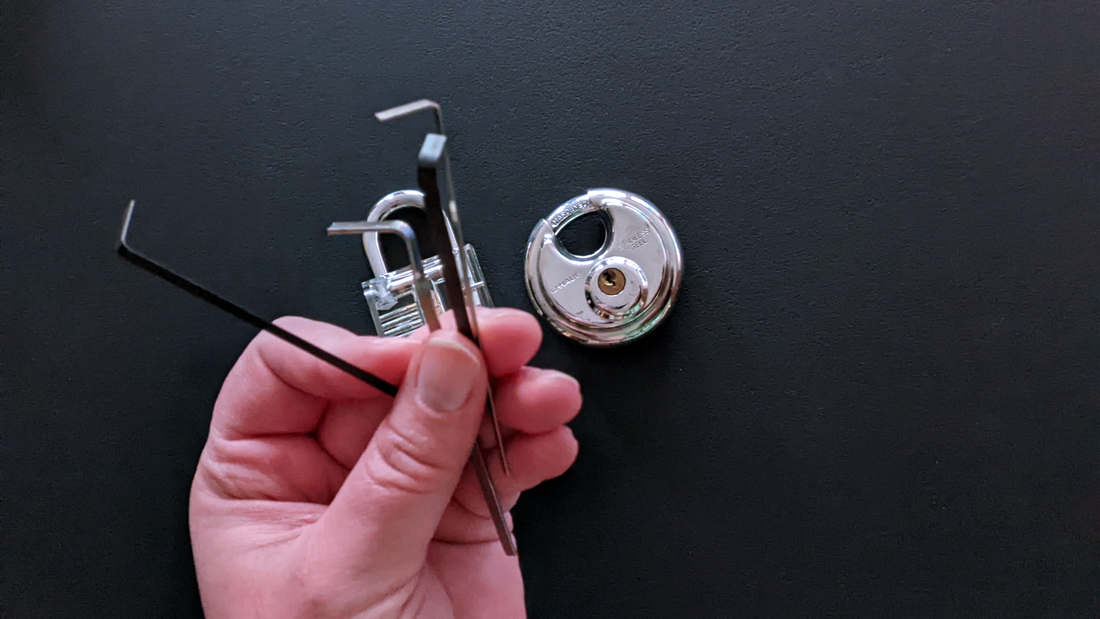How much tension do you need to pick a lock? It would help when picking a lock if you knew what kind of force you needed to exert. In this article, I will go over the method for finding out how much tension is needed to pick different kinds of locks.
Heavy tension vs light tension: What’s the difference?
Although not an exact science, you can generally tell whether you’re using heavy tension or light tension based on how much your tension tool flexes when you apply pressure during lock picking.
Will you be able to tell how much tension you’re using on a thin and flexible tension wrench versus one that’s a little bit thicker or more rigid?
If you’re using a thinner wrench, you’ll notice a lot more bend than with a thicker tool. But you can still see the amount of pressure being exerted regardless of tool thickness. Just look at the surface of your finger for an indentation. If you see one, you’re probably using heavier tension.
Avoid Beginner Mistakes with our Free Guide

See our rundown of the top 6 mistakes that beginning lock pickers make (and how to prevent them) with our free instant download.
How much pressure should you use?
The amount of tension you’ll use depends on the type of lock you’re picking, and your picking style, but in most cases it won’t require a Viking-sized arm. In fact, many beginners are taught to always be gentle with the tension tool. But you don’t have to be gentle with every lock.
Let’s take a closer look at tension strength and when to use them.
When should you use heavy tension?
I usually recommend heavy tension be reserved for locks that are cheaply made. Why? Because the pins on this type of lock are very easily locked into place. You don’t need to be delicate with them. In fact, using heavy tension will quicken the speed of your picking.
Because it's harder to get a feel for tension as a beginner, clear padlocks often allow for heavier tension.
Plus, with a cheap lock, you have to worry less about the replacement cost in the event you damage the lock (but be careful you don’t damage your tools).
Since you can bind multiple pins at once with heavy tension, it works well for cheap locks that have loose tolerance.
When should you use light tension?
When a lock is higher quality (oftentimes synonymous with harder to pick), you may need to be more careful with the amount of tension you use. Locks that are made by a single manufacturer tend to be higher quality because each part is made with more precision. The result is tighter tolerances.
With tighter tolerances, it’s more difficult to find the pin setting order. You’ll need to take your time to find a pin that provides more resistance than the others.
An important note about tension in lock picking
We talked about light tension and heavy tension. But there is a gray area, between very light (so light the tool falls out as you’re applying pressure), and very heavy (aka broken tools). The best amount of tension is oftentimes somewhere between these two extremes. If you can’t feel any resistance with any single pin, try lighter tension. If it seems like lots of pins have resistance at once, you can probably use heavier tension with the same success.
Practice tension levels and advance your skills with our multi-pin lock set
Our multi-pin lock set includes 5 cylinders, which progress from 2 to 6 pins. Each uses a different key so that you get a new experience with each lock. Check it out here: Multi-Pin Lock Set
What is the tolerance level in lock picking? Put simply, imperfections in the lock manufacturing determine the tolerance level of a lock. For example, the more undersized a pin is compared with the housing diameter, the looser the tolerance. When you have looser tolerance, you can more easily find the order in which to set the pins. In general, the more manufacturers who are involved with making a lock, the more imperfections you’ll find. The more imperfections you find, the easier it is to pick the lock.


